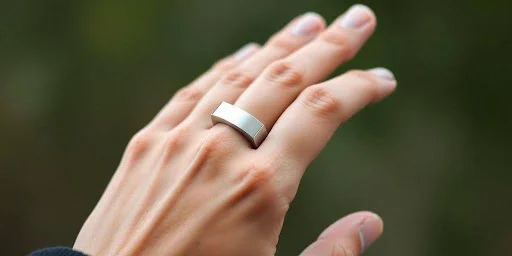Why Smart Rings Are the Next Big Thing in Fitness and Health Monitoring

A Discreet Alternative to Bulky Wearables
Forget the chunky smartwatches of the past. Smart rings offer a sleek, unobtrusive way to keep tabs on your health. They blend advanced technology into a minimalist design, making them a stylish accessory rather than a tech gadget. This discreet approach means you can track your well-being without drawing unwanted attention. The subtle power of a smart ring lies in its ability to integrate into your life without being a distraction. It’s a different way to think about wearable tech.
Seamless Integration into Daily Life
Smart rings are designed to be worn constantly, day and night. Unlike smartwatches that might be removed for charging or during certain activities, a ring stays put. This continuous wear is key to gathering consistent data, especially for sleep and heart rate monitoring. The ease of simply putting it on and forgetting about it makes it a truly integrated part of your daily routine. This constant connection provides a more fluid system for tracking your health.
Advanced Technology in a Minimalist Design
Don’t let the small size fool you. Inside these rings are sophisticated sensors capable of tracking vital signs like heart rate, sleep patterns, and even body temperature. They use technologies like photoplethysmography (PPG) to gather data. This advanced tech, packed into such a small form factor, is what makes the smart ring a compelling new player in the health monitoring space. The smart ring is a testament to how much technology can fit into a small package.
Unlocking Deeper Health Insights
Comprehensive Sleep Analysis
Smart rings offer a detailed look at your sleep. They track how long you sleep, how much time you spend in different sleep stages, and how often you wake up. This data helps you understand your sleep patterns better. Getting good sleep is key to overall health.
- Sleep duration
- Sleep stages (light, deep, REM)
- Wake-up frequency
Continuous Heart Rate Monitoring
Your heart rate is monitored all day and night. This gives a clear picture of your cardiovascular health. You can see how your heart rate changes during rest, activity, and even stress. This constant tracking helps spot trends you might otherwise miss.
Continuous heart rate monitoring provides a more complete view of your body’s response to daily life than occasional checks.
Tracking Key Vital Signs
Beyond heart rate, smart rings track other important signs. This includes skin temperature and sometimes even blood oxygen levels. These vital signs, when tracked consistently, can signal changes in your health. The smart ring technology uses this data to build a detailed health profile for you.
- Skin temperature variations
- Resting heart rate trends
- Heart rate variability (HRV)
This constant stream of data allows for a more nuanced understanding of your body’s signals, moving beyond simple fitness metrics to a more holistic view of your well-being.
Beyond Basic Fitness Tracking
Smart rings are moving past just counting steps and monitoring heart rates. They’re becoming tools for a more complete picture of your health. Think of it as getting to know your body on a deeper level, not just tracking workouts.
Proactive Wellness Through Data
These devices collect constant information about your body. This data helps spot small changes you might miss. It’s about using that information to stay ahead of potential health issues. This proactive approach means you’re not just reacting to problems, but actively working to prevent them. The goal is to use the data from your smart ring to make better daily choices for your long-term health.
Understanding Your Body’s Signals
Your body sends signals all the time. Smart rings are designed to pick up on these subtle cues. They track things like skin temperature and heart rate variability, which can tell you a lot about how your body is handling stress or recovering from exercise. Learning to read these signals can help you adjust your routine to feel better and perform at your best. It’s about listening to what your body needs.
Personalized Health Coaching
This is where smart rings really shine. The data they collect isn’t just numbers; it’s used to create personalized advice. AI analyzes your patterns to offer suggestions tailored to you. This could mean advice on when to push harder in a workout or when to prioritize rest. The system learns from your responses, making the coaching more accurate over time. It’s a smart way to get guidance that fits your unique lifestyle and health goals.
The Convenience of Smart Ring Technology
Smart rings are changing how we interact with technology, offering a blend of advanced features in a small package. They are designed for everyday use, making them a practical choice for many.
Extended Battery Life for Uninterrupted Tracking
One of the standout features of smart rings is their impressive battery performance. Unlike some other wearables that need daily charging, smart rings often last for several days, sometimes even weeks, on a single charge. This means you can track your sleep, activity, and other vital signs without worrying about your device dying mid-day or overnight. This extended battery life makes the smart ring a truly set-it-and-forget-it kind of gadget, always ready when you are.
Effortless Wearability Day and Night
The design of smart rings prioritizes comfort and discretion. They are lightweight and sleek, fitting snugly on your finger without feeling intrusive. This makes them ideal for continuous wear, whether you’re working out, sleeping, or just going about your daily routine. You can easily forget you’re even wearing one, which is a big plus for those who find bulkier wearables uncomfortable or aesthetically unappealing. The focus is on providing constant data without getting in the way.
Contactless Payments on Your Finger
Beyond health tracking, many smart rings now incorporate Near Field Communication (NFC) technology, allowing for contactless payments. This adds another layer of convenience, letting you pay for items with a simple tap of your finger. Imagine leaving your wallet or phone behind and still being able to make purchases – it’s a glimpse into a future where your most essential tools are integrated into the smallest, most accessible form factors. The smart ring is becoming a versatile tool for modern life.
The Future of Wearable Health
The landscape of personal health monitoring is rapidly evolving, and smart rings are at the forefront of this transformation. As technology shrinks and becomes more integrated into our daily lives, these small devices are poised to offer unprecedented insights and control over our well-being. The future of wearable health isn’t just about tracking steps; it’s about understanding the intricate signals our bodies send us every moment.
AI-Driven Predictive Health Analytics
Artificial intelligence is the engine driving the next generation of smart rings. By analyzing vast amounts of data collected from sensors, AI algorithms can identify subtle patterns and anomalies that might otherwise go unnoticed. This allows for predictive health analytics, moving beyond simply reporting data to forecasting potential health issues before they become serious. For instance, AI can detect early signs of illness or overexertion by monitoring changes in heart rate, skin temperature, and movement patterns, offering proactive alerts.
Integration with Smart Home Ecosystems
Imagine your environment adjusting automatically based on your body’s needs. Smart rings are set to become key components in smart home ecosystems. As a discreet, always-on sensor, a smart ring could communicate with your home’s systems to adjust lighting, temperature, or even play calming music when it detects signs of stress or poor sleep. This level of integration promises a more responsive and personalized living space, truly adapting to your personal health status.
Innovations in Biometric Authentication
Beyond health tracking, smart rings are exploring new frontiers in security and convenience through biometric authentication. The unique physiological signals captured by a smart ring can be used to verify identity, offering a secure and password-free way to access devices, make payments, or even enter secure locations. This fusion of health monitoring and biometric security represents a significant leap forward in how we interact with technology and manage our personal data.
Choosing Your Stylish Health Tracking Ring
When you’re ready to pick out a smart ring, think about what you really want it to do. It’s not just about looking good, though that’s a big part of it. One option that strikes a balance between design and function is a stylish health tracking ring from Wrong Duck, which combines fashion-forward looks with essential wellness features.
You’ve got to figure out which features matter most to you. Do you want super detailed sleep tracking, or is basic activity monitoring enough? Knowing this helps narrow down the options considerably.
Key Features to Consider
When looking at different smart rings, pay attention to the sensors they pack. Things like heart rate, body temperature, and blood oxygen levels are pretty standard now. But some rings go further, offering more advanced metrics. Also, consider how the ring connects to your phone and what kind of app it uses. A good app makes all the difference in actually using the data you collect. The best smart ring for you will match your lifestyle and health goals.
Understanding Market Leaders
Several companies are making waves in the smart ring space. Oura Ring is often mentioned for its deep sleep and readiness insights. Motiv Ring is known for its fitness focus and simple design. Circular Ring offers a lot of customization. Each brand has its own strengths, so it’s worth checking out a few to see which one feels right. Remember, the smart ring market is growing, so new players might pop up too.
Investment in Long-Term Well-being
Think of buying a smart ring as an investment in your health. While some models can seem pricey upfront, the insights they provide can help you make better choices every day. This can lead to improved sleep, better energy levels, and a general sense of well-being over time. It’s about getting a clearer picture of your body’s signals and using that information to live healthier. A smart ring can be a powerful tool for that journey.
The Future is on Your Finger
So, smart rings are definitely making a splash in the world of health tracking. They offer a more subtle way to keep an eye on things like sleep and heart rate, and that long battery life is a big plus for many. While they might not replace your smartwatch for intense workouts just yet, they’re carving out their own space. With big companies investing and new features constantly being added, it looks like these little gadgets are here to stay, giving us another way to understand our bodies better.

A Step-by-Step Guide to Downloading Your GST Certificate

What Is the Difference Between Bookkeeping and Accounting: A Simple Guide for Small Business Owners

The Ultimate Guide to Commercial Cleaning: Enhancing Workplace Hygiene and Productivity

Onsite Tire Change in Ottawa : Safe Fast & Professional Tire Services

Accelerating drug discovery through the DEL-ML-CS approach

The Role Of Fluoride In Protecting Family Smiles Over Time

Gut Health and Autoimmune Support in Scottsdale









